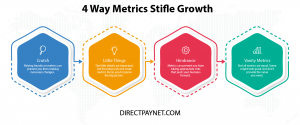
Metrics: Deadly Traps to Business Growth + How to Get Off the Hook
Mar 30, 2022 4 minute Read
Metrics are a double-edged sword. If you’re in a direct response business, you probably have a hard time imagining how metrics could possibly stifle your business growth. After all, aren’t metrics the only way to truly track progress and make sure your company is heading in the right direction?
Not exactly.
A poorly chosen metric can be a big liability and hurt your business growth. Not all metrics or KPIs are equal, and you may be following the wrong ones or at the very least misinterpreting them.
This can harm the growth of your business. In this post, we’ll go over how some of the biggest KPIs in the industry might actually be tricking you and what to avoid when measuring metrics.

Metrics, an Overview
Metrics and KPIs (key performance indicators) are essentially the same thing. They’re both measurements of some aspect of a business or its growth.
Metrics can be useful in analyzing how a business is performing, and they can help you identify areas for improvement. However, too often, people get hung up on metrics that don’t matter, or they focus on the wrong thing. That leads to inefficiencies and missed opportunities.
So, what’s the right way to use metrics? And which ones do you need to care about? Let’s start with the basics…
What are Metrics and KPIs?
A metric is a measurement of an aspect of your business. It could be as simple as “revenue” or “profits.” Or it could be something more specific, like “average order value” or “product return rate.”
You can measure nearly anything about your business. The real question is: what does it mean?
To answer that, you need to know how the metric relates to other aspects of your business — and how those aspects relate to your ultimate sales goals.
For example, if you own an e-commerce store, a low average order value might indicate that you need to change up your product mix or improve cross-sells.
For your direct response business, you need to understand which metrics are valuable and which ones aren’t in order to scale successfully.
The Problem with Metric-Driven Businesses
The problem with metric-driven companies is that they have a tendency to focus on the numbers, and forget about their customers.
For example, forcing customer service agents to keep interactions under 5 minutes so they can “help” more people. But the value of that help is most likely less than the high rate the performance metrics or quota would show.
That number doesn’t equate to customer satisfaction. And don’t you think providing a great customer experience is a more strategic objective than upping the numbers of a single metric?
Metrics are great for understanding your business, but when you start making company-wide decisions based on them, it can be dangerous.
Measuring the Wrong Things
The concept of a key performance indicator (KPI) has been around since the 1960s, when it was introduced by David Norton in his book “Financial Performance Measurement for Managerial Decision”.
KPIs are often used to measure business growth and development. But if you’re using the wrong KPIs, they can actually do more harm than good to your business, because they can distract you from achieving your business goals. The trick is to use the right kind of indicators that will help you achieve your objectives.
KPI Issues
Think about it this way: if you’re a professional boxer who’s aiming to win a fight, your goal is to knock out your opponent during the bout — not necessarily to land every punch you throw. But if every time you threw a punch and missed, your trainer turned off the lights and told you to go home, then you wouldn’t last long as a boxer. When it comes to growing a business, it’s similar — measuring every little thing that happens can be pretty demotivating if it doesn’t show positive results.
HBR’s (Harvard Business Review) September-October 2019 cover article (written by Michael Harris and Bill Tayler) expertly states, “The mental tendency to replace strategy with metrics can destroy company value.”
Manipulating Metrics
Metrics are an important aspect of business. They provide a snapshot of business performance that can be used to drive decisions. But metrics have limits: They represent one piece of a much larger puzzle and, if over-relied upon, can lead a company astray.
Why? Because metrics can be manipulated. Those who manipulate them are known as Surrogation Snares. They increase the risk of surrogation, allowing metrics to undermine the business with brutal irony.
In fact, in most organizations, you’ll find at least some employees who spend as much time gaming the system as they do actually working toward organizational goals. And that’s where the danger lies: Metrics are easy to manipulate because they don’t tell the whole story.
4 Ways Metrics Stifle Growth
You Can Use Metrics as a Crutch
We measure everything in business today. Sales, profits, ROI, engagement, productivity and more — if there’s a way to measure it, we do.
It’s a practice that can have great benefits. Metrics help you quantify your progress and underscore the need for change. But they can also be used as a crutch by business owners who are too afraid to make the necessary changes without the numbers behind them.
If you’re using metrics to hide from tough decisions, you’ll never grow your business beyond its current state.
You Can Ignore the Big Picture
It’s easy to get caught up in the little things. Without focusing on the big picture, we risk losing sight of our objectives.
In business, this happens all the time. Companies can get so caught up in the day-to-day operations that they completely lose sight of the big picture—what we call surrogation. This can hurt businesses and hold them back from growing in a sustainable way.
Metrics are great for helping you stay on top of your business — as long as you remember that they’re just tools for managing your business, not definitive indicators of success.
They Prevent You from Taking Risks
Metrics are all about removing risk. The deviation is the enemy – it makes things unpredictable.
So, when we follow a metric, we’re trying to find the path that will most likely lead us to an outcome with minimal deviation. We’re trying to play it safe.
But if we want our businesses to grow, we must take risks. We’ll need to try new things. We’ll need to break the rules and step outside of what’s proven to work.
You Rely on Vanity Metrics
Vanity metrics are numbers that are easily tracked, but don’t actually matter much in the grand scheme of your company’s growth. Vanity metrics aren’t always bad, but they can be misleading if you use them as a stand-in for meaningful metrics.
A few examples of vanity metrics:
- The number of people who visit your website
- The number of people who subscribe to your newsletter
- The number of likes or shares on social media posts
Let’s say you run a podcast. You might be tempted to measure its success by counting the number of downloads it gets every month. But what does that tell you?
A high download count might mean that you have a great audience, or it could just mean that a lot of people subscribe to your show and automatically download it every week without actually listening to it.
Not Everything Can Be Measured
Metrics can’t tell you how to do your job, but they can tell you if you’re doing it right.
The kind of analytics you choose will depend on your industry, your product and your business model, but all metrics have a few things in common:
- Metrics measure what happened in the past, not what will happen in the future.
- Metrics quantify performance against a set standard.
- Metrics are backward-looking; they provide objective facts about what has already occurred.
By nature, metrics aren’t predictive; they’re observational. A metric might indicate that there’s a problem that needs addressing, but it probably won’t tell you why there’s a problem or how to fix it.
Your Business Is More Than KPIs. Become a Better Direct Response Business Owner by Learning When to Let Numbers Guide You.
Once your team understands that metrics don’t instantly translate into faster or better decisions, you can use them to guide growth.
Here’s how you can look beyond metrics:
Innovation. Innovation is fundamentally about discovering new things and adapting to them. This means that success depends on your ability to look beyond the past and see what’s happening around you.
Goals. To properly gauge your business’s health and growth, you need to understand your business’s goals. You should have goals for both short-term success and long-term growth.
Developing an incentive system or incentive compensation can create a balanced scorecard to coordinate behaviors between employee performance and sales culture.
Decisions. You need to also understand what decisions you are likely to make based on the metrics you are tracking. Tracking the right metrics will lead to better decision making.
Allowing metrics to make decisions every time will diminish the ultimate strategy of building long-term customer relationships and it can destroy company value (per the aforementioned HBR article).
Wrapping Up
Numbers don’t tell the whole story on their own, they just give a picture of what is going on.
One metric that doesn’t lie is the number of businesses shut down for using the wrong merchant account. As a direct response business, you’re high-risk. That means you need a high-risk merchant account and a payment processor that backs your business model.




